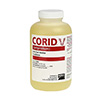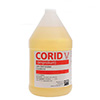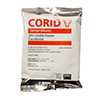Coccidiosis in Chickens: Symptoms, Evolution & Treatment
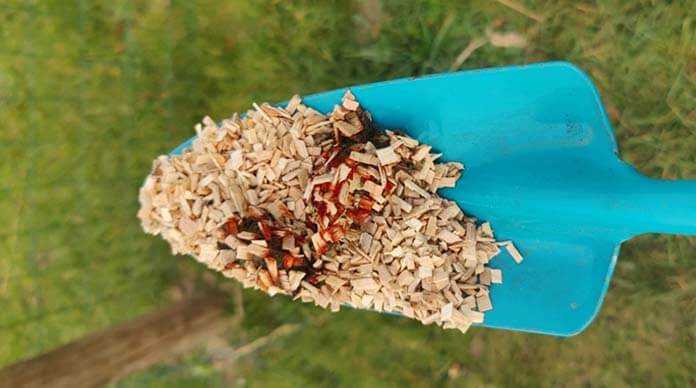

Coccidiosis is a widespread disease that can quickly wipe out a large part of your flock. It’s one of those diseases every chicken owner should be aware of since acting fast is critical in case of an infection.
We’ll take you through everything to know about coccidiosis in chickens.
- What is Coccidiosis?
- Symptoms of Coccidiosis
- Diagnosis of Coccidiosis
- Treatment of Coccidiosis
- Prevention of Coccidiosis
- Evolution of Coccidiosis
- Conclusion
What is Coccidiosis?
Coccidiosis (aka cocci) is a parasitic infection of the intestines prevalent in backyard flocks. It causes (bloody) diarrhea and weight loss and is usually seen in birds between 1 to 4 months old. The parasites are coccidian protozoa, peculiar single-celled organisms that look like bacteria on steroids.
These parasites thrive in many animals, like dogs, cats, and even humans, but most species have their personalized variety of coccidia. Chickens are susceptible to the same coccidia as geese and ducks.
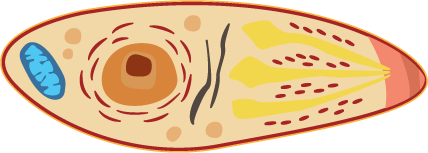
The parasite is exceptionally persistent and can survive multiple years in dirt and poo. Chickens usually ingest the parasite via contaminated water or food. Once infected, the disease can spread quickly, and the chicken will have red, bloody diarrhea.
Left untreated, coccidiosis can be fatal for your chicken. Luckily you can treat it with antibiotics. After recovery, a chicken develops protective immunity.
Symptoms of Coccidiosis in Chickens
The symptoms of coccidiosis take 5 to 6 days to develop after infection (the incubation period). Chickens usually go asymptomatic for a couple of days and suddenly become restless and ill on the fourth day after infection. The greatest numbers of deaths occur already on the 5th day.
The most recognizable and well-known symptom is blood in the chicken’s droppings. You don’t immediately have to panic when you see some blood in their poo: they frequently shed their intestinal lining in cecal droppings. However, stay alert if their poo is very liquid and bright.
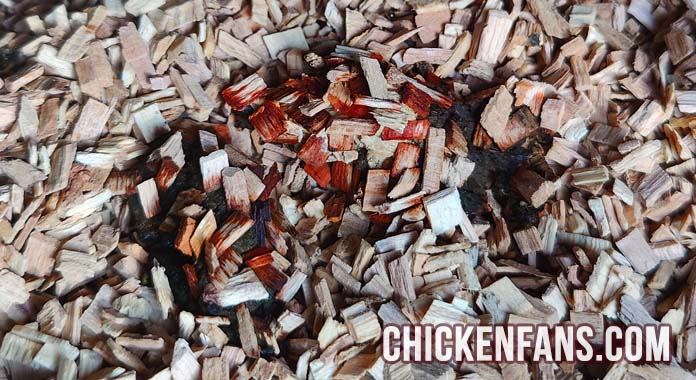
And be especially careful if you notice any of the following symptoms:
- Ruffling of the feathers
- Weak, restless, lethargic, and falling over all the time
- Diarrhea and dehydration
- Pale skin, pale comb, and wattles compared to other flock members
- Weight loss and refusing to eat (or growth stop)
- Laying no (or less) eggs
- Droopy, dull, or glazed eyes
Chickens fighting a cocci infection are susceptible to other diseases and may show several additional symptoms. Unfortunately, some chickens die from internal damage before showing any signs of illness.
Diagnosis of Coccidiosis
If you observe symptoms, a veterinarian can diagnose coccidiosis via fecal examination of the chicken’s droppings. The observation is done microscopically with a fecal flotation test.
A vet can also perform a post-mortem examination by observing gross lesions or confirming the presence of coccidia in the intestines.
To perform a flotation test, the vet mixes the chicken’s stool with a special liquid that makes the parasite eggs, or oocysts, float on top. You can recognize the eggs through the microscope using a 40X objective lens. Vets use the same routine test to detect worms and other parasites.
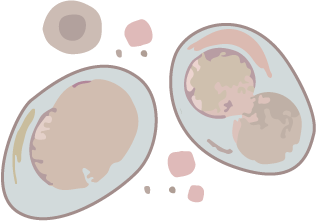
If you use bedding that absorbs the droppings, like pine shavings, switching to a clean dropping board can help to capture the poo.
When a chicken has already died, the vet can still make a diagnosis post-mortem. Diagnosing or ruling out coccidiosis is essential to protect the rest of the flock.
Treatment of Coccidiosis
The most common treatment for coccidiosis is Amprolium (Corid). It’s a chemical compound that mimics vitamin B1 (thiamin) and prevents the parasite from synthesizing carbohydrates, so it can’t replicate and dies. Amprolium is the active ingredient. You can get the drugs over the counter in most countries, albeit under different brand names. Most people know Amprolium under the brand name: Corid.
Let’s address how to use Corid for both prevention and treatment:
- CORID LIQUID & POWDER: You can use Corid both for prevention and treatment of coccidiosis by mixing the correct dosage in the drinking water. For treatment, you need a higher dose. Find the correct and FDA recommended dosage in our comprehensive table.
Corid Dosage for Treatment & Prevention
The following table gives a practical overview of how to dose Corid 9.6% Solution and 20% Powder for prevention and treatment in chickens of different ages.
| Type | Use | Chicken Weight | Dosage | Days |
|---|---|---|---|---|
| Liquid 9.6% | Treatment | Adult | 1 to 2 tsp/gallon | 5 |
| Liquid 9.6% | Treatment | Bantam | 1/4 to 1/2 tsp/gallon | 5 |
| Liquid 9.6% | Prevention | Adult | 1/2 tsp/gallon | 7-14 |
| Liquid 9.6% | Prevention | Chick | 1/2 tsp / 5 gallon | 5 |
| Powder 20% | Treatment | Adult | 3/4 to 1.5 tsp/gallon | 5 |
| Powder 20% | Treatment | Bantam | 1/4 to 1/2 tsp/gallon | 5 |
| Powder 20% | Prevention | Adult | 1/3 tsp/gallon | 7-14 |
| Powder 20% | Prevention | Chick | 1/2 tsp / 5 gallon | 5 |
To learn more about Corid, check out our ‘Corid for Chickens‘ article with in-depth information about the dosage and treatment. It gives much more information on preventing and treating mild and severe outbreaks.
Always treat the entire flock, as infected chickens can be asymptomatic. Clean the chicken coop thoroughly and eliminate all droppings as much as possible. Give extra attention to hygiene in their feeding areas and ensure food and water are off the ground.
Treatments are periodically repeated after five days (the prepatent period of the parasite). For severe infections, consider adding vitamin K to the chicken’s diet. It’s common to see the blood disappear within 24 hours.
Vitamin B1
When treating with Amprolium, don’t give your chickens extra vitamin B1. It will interfere with the Amprolium that tries to deprive the parasite of its energy sources.
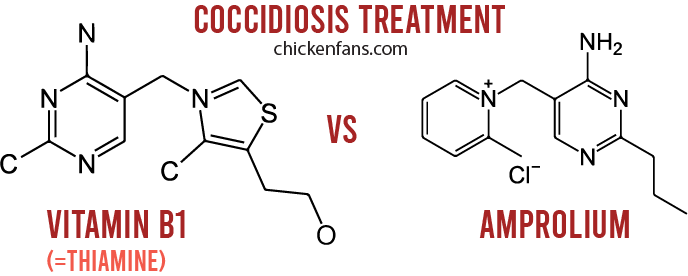
After treatment, you can give some extra vitamin B during recovery, as vitamin B1 is an essential micronutrient that the chicken’s body can not make.
Alternatives to Amprolium
Amprolium is not the only possible treatment. Multiple antiprotozoal agents can kill coccidia parasites like Toltrazuril and Sulfonamides. Always follow the recommendations of the vet for the proper medication.
There are no alternatives to proper medicines to treat coccidiosis.
That said, chicks with coccidiosis show much fewer negative symptoms when they receive probiotics. Especially probiotic strains of Pediococcus, Lactobacillus, and Saccharomyces are effective against cocci.
Proper food and supplements can also help to boost the chicken’s immune system. Some herbs, as well as garlic and onion extracts, are known to boost the chicken’s immune system and improve the microbiome of the intestines. However, they are by no means a replacement for proper medication.
Let’s discuss some other alternative treatments you might have heard of.
Milk Flush
The idea of using milk to treat coccidiosis may sound familiar. Some people give raw milk to their chickens to provoke diarrhea and clean the intestines. Others feed their chickens with yogurt and milk, believing that the microbes will fight the coccidia in the intestines.
A healthy microbiome is always beneficial, and using poultry probiotics to boost the immune system can reduce 70–80% of losses due to coccidiosis [RAO]. Although probiotics will never stop the disease, they can boost the immune system to fight coccidiosis. Check our article on probiotics for chickens to see what is best for your flock.
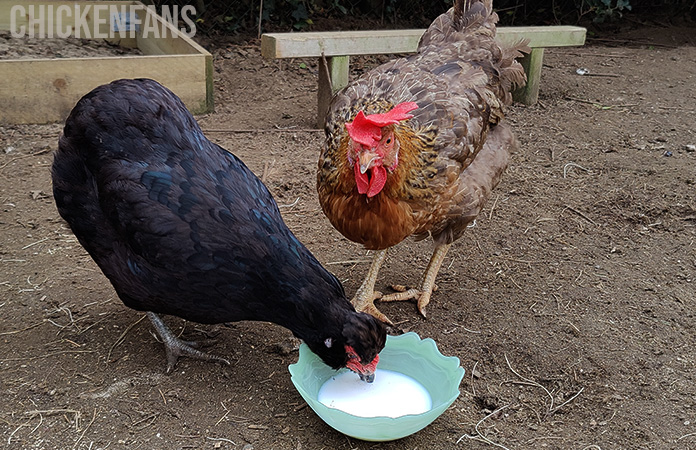
Unfortunately, milk is not the probiotics sick chickens need. Chickens are lactose-intolerant and do not have the enzymes necessary to break down lactose into its main simple sugars – glucose and galactose.
Furthermore, although they look like giant bacteria cells, these coccidian protozoa are no bacteria. The parasite will not directly be influenced by the microbes in milk and won’t be eliminated by competitive exclusion. The benefits of poultry probiotics rather come from their beneficial effects on the immune system.
To fulfill the nutritional requirements of chickens, a large amount of milk would need to be consumed. Excessive consumption of milk can lead to diarrhea.
A milk flush to induce diarrhea will completely destroy the healthy microbiome. It’s not an alternative to proper probiotics.
Diatomaceous Earth (DE)
Some people believe that giving DE to the birds will help against coccidiosis. The underlying idea is that the sharp edges of the fossilized diatoms damage the parasites. Official ATTRA documentation and Indian researchers state that no scientific evidence supports this.
However, some positive results were reported in pigeons during a study conducted in Poland in 2015. Polish researchers concluded that the Eimeria coccidia oocysts could be considerably decreased by supplementation of diatomite in the pigeon’s grain mix diet.
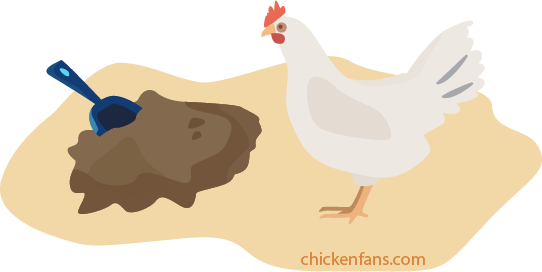
The journal of animal science published the results of research performed on lambs, where they observed lower parasite egg counts (175eggs/g vs. 753eggs/g), and they concluded that there may have been a small effect of DE.
Researchers from California and Vancouver found that adding 2% of DE to the diet of egg layers did significantly impact parasite load in the intestines. However, their results varied largely by the breed. Lowmann Brown egg layers, which are parasite resistant by nature, did not benefit from any DE addition to their feed. But for Bovan Brown hens, adding DE to their diet reduced the amount of Eimeria parasites in the intestines of the chickens.
Prevention of Coccidiosis
Prevention starts with the vaccination of day-old chicks. If the chicks are not vaccinated, you can opt for medicated starter feed if that’s still available in your region. Just don’t combine the two. Vaccinated chicks don’t need medicated starter feed.
Coccidiosis often occurs in stressed chickens living in crowded confinement conditions, resulting in overpowering outbreaks. The infection is most common in floor-raised chickens.
The rest of the preventive measures focus on providing a hygienic, dry, and healthy environment for your chickens:
- clean the chicken coop and your tools regularly
- ensure your flock has clean water and consider the use of water nipples
- provide enough space, check our specific guide on space requirements and the chicken coop size calculator to calculate adequate numbers for the size of the chicken coop and run for your particular flock
- make sure the chicken coop has all elements set up correctly, like nesting boxes, roosting perches with correct dimensions, and proper ventilation
- keep new flock members in isolation as they might carry parasites
- try to avoid contact with other birds
- avoid bringing home new strains of coccidiosis on your clothes after visiting other flocks
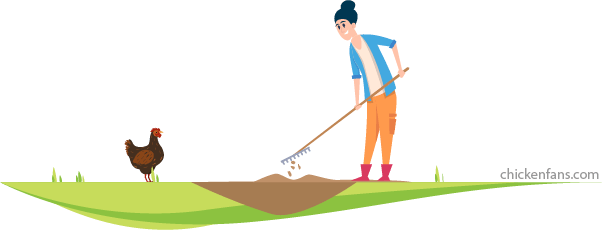
It is well-known that probiotics help minimize the prevalence of coccidia. However, probiotics do not directly impact the coccidia by competitive exclusion. Probiotics rather facilitate the strengthening of the gut microbiota of the birds and boost the immune system. This ultimately reduces the impact of coccidia. Check our article on probiotics for chickens to see what’s best for your flock.
Be especially careful with younger chickens. The greatest chance of infection is in birds from four to eight weeks old. They didn’t have time to build up any natural immunity yet.
Evolution of Coccidiosis
The lifecycle of coccidiosis is exceptionally complex, and researchers are still uncovering the secrets of this extraordinary part of the animal kingdom. Many details of the core mechanisms were only discovered and described in the last 20 years.
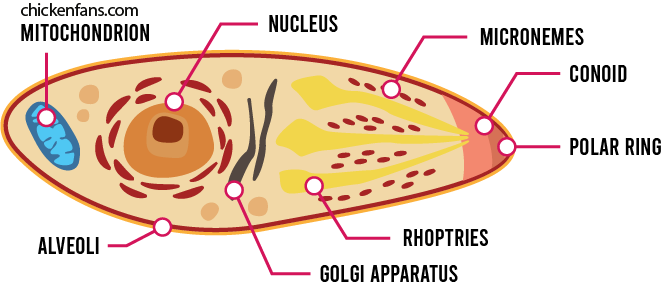
Coccidiosis is not caused by a virus, like fowlpox or Marek’s disease.
The parasites responsible for coccidiosis are protozoa, single-celled organisms. These protozoa look a bit like big bacteria but come with their own set of exotic cell structures. They are composed of unique organelles like rhoptries and micronemes that seem to be stolen from science fiction literature. Scientists realized these protozoa were neither animals nor plants in the eighties. These bastards got their own classification, with the latest taxonomy published as recently as 2000.
Coccidia
There are 50.000 different types of single-cell species in the protozoa kingdom. It’s the Coccidia type that causes the dreaded coccidiosis in animals. And for chickens specifically, it’s strains of the genus Eimeria. Over 1000 species of Eimeria exist that infect different host animals such as chickens, ducks, turkeys, cattle, dogs, and cats.
Eimeria are part of a group of parasites with the same characteristics called the Apicomplexa. Their name is no coincidence; they are called complex and certainly live up to their name!
Life Cycle
To understand how coccidiosis develops in your flock of chickens and how to control it eventually, we’ll take a deeper dive into the life cycle of these little creatures.
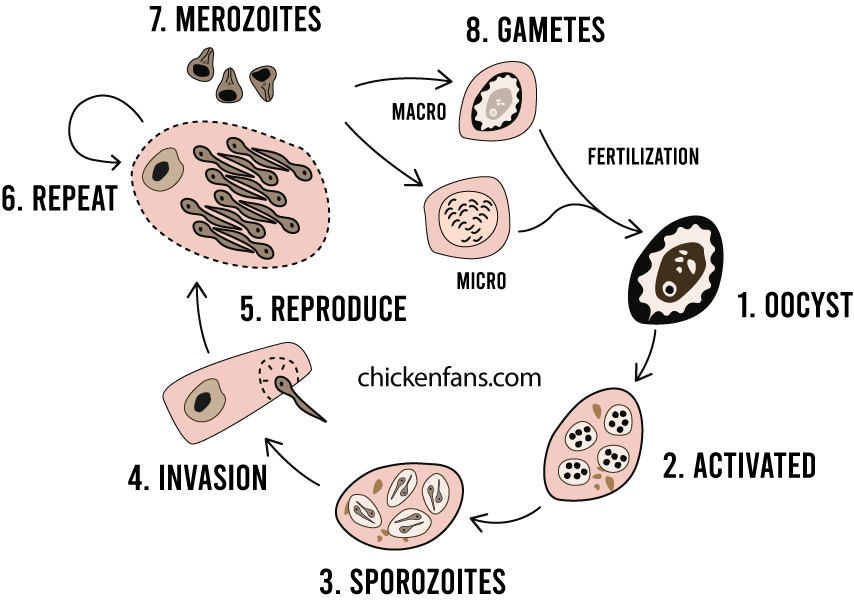
Oocyst
It all starts outside the chicken’s body, in the dirt, with what’s called an oocyst. An oocyst is a parasitic egg that is so exotic and strong that it seems to come from another planet. The shell is even resistant to disinfectants. The oocyst contains a passive form of coccidiosis, which can survive outside the chicken’s body for multiple years.

When chickens are pecking and scratching in the litter on the ground, they also pick up the tiny oocysts. When an oocyst enters the chicken’s body, it immediately activates the coccidiosis strains inside the shell. The chicken’s warm and moist internals enable rapid development.
Within 24 hours, new parasitic cellular organisms grow in the oocyst, called sporozoites. These sporozoites are the enemy soldiers that will attack the chicken’s body later on.
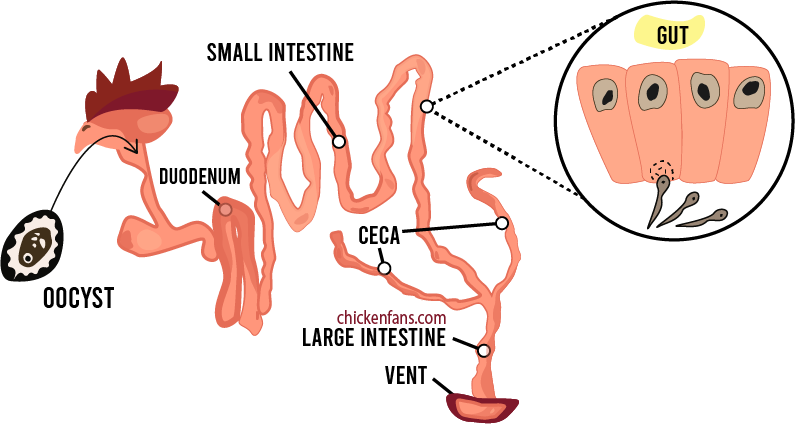
Sporozoites
As part of the digestion, chemicals in the stomach and gut of the chicken break down the hard shell of the oocysts. This releases the army of sporozoites inside the intestines of the chicken. The sporozoites attack and force themselves into the gut cells of the chicken.

When they are inside, they take over the cell and transform it into a factory to create a new kind of parasitic soldier called merozoite.
They create so many merozoites that the original cell will eventually explode. All this happens about four days after the infection. With so many damaged cells in the chicken’s intestines, plenty of blood comes along with their poo. At this moment, the chicken starts to become seriously ill.
Merozoites
Thousands of merozoites are released into the chicken’s body every time a cell explodes. The merozoites are attacking other cells in the body to take over and create even more merozoites. This process repeats multiple times until millions of parasitic soldiers fight in the chicken’s body. At this critical point, several chickens will die from internal damage.
Gametes
After a certain period, the merozoites suddenly stop attacking the chicken’s body. They somehow have an attack plan stored in their DNA and know precisely when to stop attacking the chicken from the inside.
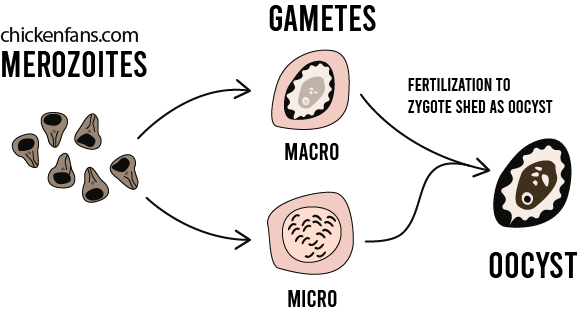
Fascinating enough, they start a completely new process where the soldiers suddenly transform into female and male sex cells called gametes. The sex cells find each other, and – just like in humans – fertilization occurs, which results in the birth of a new parasitic oocyst. This newborn oocyst piggybacks on the chicken’s droppings to the outside world. That happens somewhere around the sixth day after infection.
Spreading
The one oocyst that we started with has now been replicated into half a million new oocysts, spread over the chicken coop, and run. These oocysts are waiting to be picked up by another one of the chickens in the flock. And that’s how the disease spreads and can infect other birds rapidly.
Luckily enough, the parasite replication is self-limiting and has a fixed number of cycles.
Conclusion
Coccidiosis is a severe disease caused by a parasite that can be controlled with proper husbandry management practices. Prevention and vaccination are vital in avoiding coccidiosis in chickens as much as possible, especially in younger birds.
It is, however, impossible to avoid altogether. Therefore, it’s essential to understand coccidiosis’s symptoms and basic mechanics.
If you see blood in the droppings and notice symptoms, act immediately and check the droppings with a vet. Waiting too long will increase the risk of losing many chickens in your flock.

Dr. Muhammad Farhan is a licensed veterinarian holding a masters degree in Nutritional Sciences. Currently he’s pursuing a PhD in Nutritional Sciences at University of Agriculture, Faisalabad.
